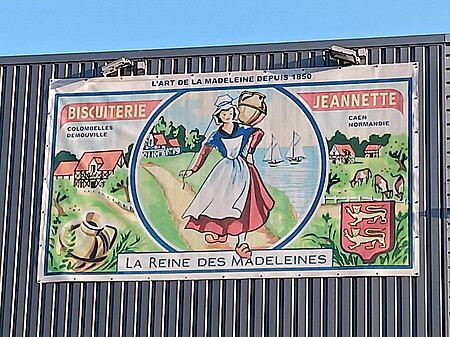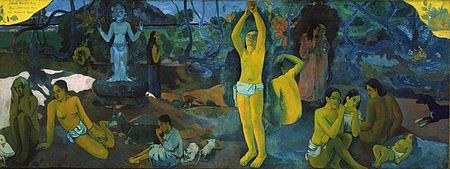Ruby character
| |||||||||||||||||||||||||||||||||||||||||||||||||||||||||||||||||||||||||||||||||||||||||||||||||||||||||||||
Read other articles:

Biochemical process applied in industrial production This article needs additional citations for verification. Please help improve this article by adding citations to reliable sources. Unsourced material may be challenged and removed.Find sources: Industrial fermentation – news · newspapers · books · scholar · JSTOR (April 2012) (Learn how and when to remove this message) Industrial fermentation is the intentional use of fermentation in manufacturing proc…

Édifice La AdriaticaPrésentationFondation 1922Style ÉclectismeArchitecte José Espiau y Muñoz (d)LocalisationLocalisation Séville EspagneCoordonnées 37° 23′ 15″ N, 5° 59′ 40″ Omodifier - modifier le code - modifier Wikidata L'Edifice de La Adriática de Séville a été construit entre 1914 et 1922 dans la rue Cánovas del Castillo, actuelle Avenida de la Constitucion. Histoire Projetée par l'architecte José Espiau et Muñoz, en…

Pour les articles homonymes, voir Jeannette. Jeannette 1850 Magasin d'usine à Colombelles Création 1850 à Caen Dates clés 1925 : Association Lucien Jeannette, Pierre Mollier et Albert Boissel 1986 : achat par Gringoire-Brossard 2013 : liquidation judiciaire2015 : Financement participatif Fondateurs Pierre Mollier Personnages clés Lucien JeannetteJean et Raymond VinchonGeorges Viana Forme juridique Société par actions simplifiée Slogan Soyez gourmand mais exigeant! Si�…

Sceaux 行政国 フランス地域圏 (Région) イル=ド=フランス地域圏県 (département) オー=ド=セーヌ県郡 (arrondissement) アントニー郡小郡 (canton) 小郡庁所在地INSEEコード 92071郵便番号 92330市長(任期) フィリップ・ローラン(2008年-2014年)自治体間連合 (fr) メトロポール・デュ・グラン・パリ人口動態人口 19,679人(2007年)人口密度 5466人/km2住民の呼称 Scéens地理座標 北緯48度46�…

この項目には、一部のコンピュータや閲覧ソフトで表示できない文字が含まれています(詳細)。 数字の大字(だいじ)は、漢数字の一種。通常用いる単純な字形の漢数字(小字)の代わりに同じ音の別の漢字を用いるものである。 概要 壱万円日本銀行券(「壱」が大字) 弐千円日本銀行券(「弐」が大字) 漢数字には「一」「二」「三」と続く小字と、「壱」「弐」…

Depictions of pigs in culture Painting of Saint Anthony with a pig in background by Piero di Cosimo c. 1480 Pigs, widespread in societies around the world since neolithic times, have been used for many purposes in art, literature, and other expressions of human culture. In classical times, the Romans considered pork the finest of meats, enjoying sausages, and depicting them in their art. Across Europe, pigs have been celebrated in carnivals since the Middle Ages, becoming specially important in …

The Regional Renewable Energy Procurement Project is an energy project in the San Francisco Bay Area, set to develop 186 sites that will generate a total of 31 megawatts, enough electricity for more than 6,000 residences. The project is expected to create more than 800 jobs.[1][2] In May 2015, Gina McCarthy, head of the federal Environmental Protection Agency, presided over a dedication ceremony at the first designated site for the project, at the location of Hayward's former lan…

此条目序言章节没有充分总结全文内容要点。 (2019年3月21日)请考虑扩充序言,清晰概述条目所有重點。请在条目的讨论页讨论此问题。 哈萨克斯坦總統哈薩克總統旗現任Қасым-Жомарт Кемелұлы Тоқаев卡瑟姆若马尔特·托卡耶夫自2019年3月20日在任任期7年首任努尔苏丹·纳扎尔巴耶夫设立1990年4月24日(哈薩克蘇維埃社會主義共和國總統) 哈萨克斯坦 哈萨克斯坦政府與�…

الهيئة السعودية للمدن الصناعية ومناطق التقنية مدن—MODON تفاصيل الوكالة الحكومية البلد السعودية الاسم الكامل الهيئة السعودية للمدن الصناعية ومناطق التقنية تأسست 2001 المركز الرياض، السعودية الموظفون 291 (2014) الإدارة الوزراء المسؤولون بندر الخريف، رئيس مجلس الإدارة و…

Частина серії проФілософіяLeft to right: Plato, Kant, Nietzsche, Buddha, Confucius, AverroesПлатонКантНіцшеБуддаКонфуційАверроес Філософи Епістемологи Естетики Етики Логіки Метафізики Соціально-політичні філософи Традиції Аналітична Арістотелівська Африканська Близькосхідна іранська Буддійсь…

Частина серії проФілософіяLeft to right: Plato, Kant, Nietzsche, Buddha, Confucius, AverroesПлатонКантНіцшеБуддаКонфуційАверроес Філософи Епістемологи Естетики Етики Логіки Метафізики Соціально-політичні філософи Традиції Аналітична Арістотелівська Африканська Близькосхідна іранська Буддійсь…

2015年3月,国务院总理李克强出席总理中外记者会 国务院总理记者会,又称“总理答记者问”,是由作为中华人民共和国政府首脑的国务院总理主讲的中外记者会,一般在全国人民代表大会会议闭幕后举行。[1]总理记者会始于1988年,当时的国务院总理李鹏接受第七届全国人大一次会议新闻发言人曾涛的邀请,跟来自中国大陆、港澳、台湾和外国的记者见面。在第一次记�…

Marie TrintignantMarie Trintignant bersama ayahnya pada tahun 1979.Lahir(1962-01-21)21 Januari 1962Boulogne-Billancourt, PrancisMeninggal1 Agustus 2003(2003-08-01) (umur 41)Neuilly-sur-Seine, PrancisPekerjaanAktrisTahun aktif1967–2003Suami/istriSamuel Benchetrit (m. 1998)Anak4Orang tuaJean-Louis TrintignantNadine Marquand Marie Trintignant (pengucapan bahasa Prancis: [maʁi tʁɛ̃tiɲɑ̃] ( simak); 21 Januari 1962 – 1 Agustus…

Démonstration de la lévitation du carbone pyrolytique au-dessus d'aimants permanents. Le carbone pyrolithique étant un matériau similaire au graphite, est donc un des matériaux possédant l'une des plus grandes susceptibilités diamagnétiques connues. Lévitation d'une grenouille vivante dans un champ magnétique de 16 teslas. Le diamagnétisme est un comportement des matériaux qui les conduit, lorsqu'ils sont soumis à un champ magnétique, à créer une très faible aimantation opposée…

Menara ApiAlov qüllələriInformasi umumStatusSelesai (MOO)Jenisperkantoran, perumahan, hotel, pusat perbelanjaanLokasiBaku, AzerbaijanMulai dibangunOctober 2007Pembukaan2013BiayaUS$350 jutaPemilikAzinko Development MMCTinggiAtap182 m (597 ft) - Menara Api 1[1]165 m (541 ft) - Menara Api 2[2]161 m (528 ft) - Menara Api 3[3]Data teknisJumlah lantai33/30/28Desain dan konstruksiArsitekHOKTeknisi strukturBalkar MühendislikKontraktor utamaDIA Ho…

Sedimentary rock exposure in Colorado and Utah, U.S. For AMD's APU codename, see AMD Raven Ridge. For the place in Washington state, see Raven Ridge (Washington). Raven Ridge. NASA satellite photo, 2008.[1] Raven Ridge is a starkly visible sedimentary rock exposure located in Rio Blanco County, Colorado and Uintah County, Utah, USA. It is managed by the Bureau of Land Management. The ridge contains a diverse selection of rare plants unique to the state of Colorado. Geology The Raven Ridg…

This article is about the year 1984. For the novel, see Nineteen Eighty-Four. For other uses, see 1984 (disambiguation). MCMLXXXIV redirects here. For the album, see MCMLXXXIV (album). 1984 January February March April May June July August September October November December Clockwise from top-left: a civil unrest movement demands direct presidential elections in Brazil; Indian prime minister Indira Gandhi is assassinated by two of her security guards, heralding the beginning of the anti-Sikh ri…

Cet article est une ébauche concernant la littérature française. Vous pouvez partager vos connaissances en l’améliorant (comment ?) selon les recommandations des projets correspondants. Claudine s'en va Auteur Colette Pays France Genre Roman Éditeur Paul Ollendorff Date de parution 1903 Chronologie Claudine en ménage Le Retraite Sentimentale modifier Claudine s'en va est un roman français de Willy et Colette, paru en 1903 aux éditions Paul Ollendorff. Il est le quatrièm…

外来種(がいらいしゅ)とは、もともとその地域にいなかったのに、人為的に他の地域から入ってきた生物のこと[1]。アレロパシーが強い植物、など、その一部は生態系や経済に重大な影響を与える際には、環境問題のひとつとして扱われる[2]。ただ、飼育や畑などといった、管理している区域は除く。 類義語に移入種、帰化種、侵入種、外来生物がある。英…

くしもとちょう 串本町 潮岬 串本町旗2006年4月10日制定 串本町章2006年4月10日制定 国 日本地方 近畿地方都道府県 和歌山県郡 東牟婁郡市町村コード 30428-0法人番号 9000020304280 面積 135.67km2(境界未定部分あり)総人口 13,558人 [編集](推計人口、2024年6月1日)人口密度 99.9人/km2隣接自治体 東牟婁郡:古座川町、那智勝浦町 西牟婁郡:すさみ町町の木 ツバキ町の花 モチノ�…

